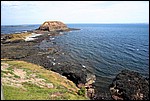The Nobbies and Pyramid Rock, Phillip Island
 nobbies1.jpg |
The Nobbies, the most south-easterly point of Phillip Island, are named after the rock stacks or nobs that stick out of the water, most notably Seal Rocks, an Australian Fur Seal colony (visible on the horizon at the top left of this photo). The Nobbies are composed of weathered Eocene basalts (40-48 Ma) of the Flinders Subprovince (they have been previously referred to as the "Older Basalts", but the term fell out of use in 2007). Each of the flows feature a prominent, clay-rich weathering profile, here seen as massive red to white layers beneath the black basalt of the overlying flow base. Individual flows here are probably no more than 1-2 m thick. Notice the prominent shore platform on the peninsula between the Nobbies and Phillip Island. It is also composed of black basalt and you can see where the waves have been eroding out the softer weathered basalt leaving overhangs and tunnels. A large part of Phillip Island is composed of Flinders Subprovince basalts. |
 pr1.jpg |
Pyramid Rock (in the distance), on the southern shore of Phillip Island east of The Nobbies, is also composed of Eocene basalts of the Flinders Subprovince. |
 pr2.jpg |
Here's a close-up of the headland with Pyramid Rock in the background. Notice that Pyramid Rock itself is a pyramid-shaped tumble of rocks, a remnant of a lava flow that once connected the main outcrop in the foreground to the shore platform. Pay close attention to this photograph. The pinkish rocks at the base of Pyramid Rock are Devonian Woolamai Granite. These are overlain by black columnar basalts of the Flinders Subprovince, but what are the whitish patches in the foreground between the basalts and the grass underneath the lookout? It's a very important piece of the puzzle of the landscape evolution story of Southeast Victoria and Phillip Island. |
 pr3.jpg |
Look closely at this photograph. The students are standing on the headland on bleached white material composed of subangular quartz fragments and kaolinite. What are these the typical weathering products of? Think back to Mt Oberon. The black rock in the centre of the photo is a thin basalt lava flow. It has a thin weathering profile, but is again overlain by the deposits of quartz and white kaolinite. What's the white material? It's weathered granite of course, most probably weathered Devonian Woolamai Granite. |
 pr4.jpg |
Looking more closely we can see that this weathered granite material is alluvial sediment - you can see bedding in this exposure. Notice the cracking in the sediments underneath? This is typical of smectite clay-rich sediments from basalt weathering. You can learn more about basalt weathering at Flynns Beach. So, what's going on at The Nobbies and Pyramid Rock? In the Early Tertiary, the Phillip Island area seems to have been made up by a series of granite islands surrounded by a shallow sea. Between about 48 and 40 million years ago, basaltic eruptions on and around Phillip Island extruded the lavas that we see today. The lavas covered over some of the granite islands, extruding over the sandy sediments. In other places, sandy sediments were washed over the top of the lavas. This indicates that there was considerable erosion occurring around the time the basalts were being erupted. |
Learn more about Phillip Island (and processes occurring at Flynn's Beach in general) by reading: W.D. Birch ed. 2003. Geology of Victoria. Geological Society of Australia special publication No. 23. 842 p. |
|